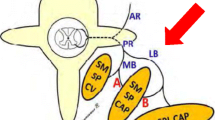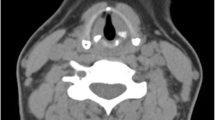Abstract
Background
Spasmodic torticollis (ST) is characterized by sustained, involuntary, and painful spasms of specific muscle (s), which results into abnormal posture of the neck and head. Although various treatments for ST have been introduced, none of them shows absolute effectiveness. Earlier research from our department showed that microvascular decompression (MVD) surgery is effective in the short-term for ST patients with confirmed accessory nerve compression. However, the long-term outcome of MVD remains unknown.
Method
Twelve ST patients with confirmed accessory nerve compression received MVD surgery of their accessory nerves. We utilized the Toronto Western Spasmodic Torticollis Rating Scale (TWSTRS) to evaluate the long-term outcome (5.4 ± 0.87 years).
Results
The MVD lowered total TWSTRS scores by 42.8 % in all ST patients. This result, however, only counted for moderate relief. Interestingly, we observed that the laterocollis (LC) subtypes of ST (n = 3) obtained a higher TWSTRS score improvement (86.9 ± 6.2 %), compared to that of the non-LC (28.1 ± 12 %) (P =0.0001). Additionally, the disability (92.7 ± 2 %) subscale score in the LC subtypes had the most prominent improvement compared to the pain (88.1 ± 5.1 %) and severity (81.3 ± 10.5 %).
Conclusions
In the cases of confirmed accessory nerve compression, the MVD could be considered as a treatment alternative for ST, especially for the LC subtypes.

Similar content being viewed by others
References
Alafaci C, Salpietro FM, Montemagno G, Grasso G, Tomasello F (2000) Spasmodic torticollis due to neurovascular compression of the spinal accessory nerve by the anteroinferior cerebellar artery: case report. Neurosurgery 47:768–771, discussion 771–772
Albanese A, Asmus F, Bhatia K, Elia A, Elibol B, Filippini G, Gasser T, Krauss J, Nardocci N, Newton A, Valls-Solé J (2011) EFNS guidelines on diagnosis and treatment of primary dystonias. Eur J Neurol 18:5–18
Brashear A, Lew M, Dykstra D, Comella C, Factor S, Rodnitzky R, Trosch R, Singer C, Brin M, Murray J, Wallace J, Willmer-Hulme A, Koller M (1999) Safety and efficacy of NeuroBloc (botulinum toxin type B) in type A-responsive cervical dystonia. Neurology 53:1439–1446
Chan J, Brin M, Fahn S (1991) Idiopathic cervical dystonia: clinical characteristics. Mov Disord 6:119–126
Comella C, Stebbins G, Goetz C, Chmura T, Bressman S, Lang A (1997) Teaching tape for the motor section of the Toronto Western Spasmodic Torticollis Scale. Mov Disord 12:570–575
Dressler D (2004) Clinical presentation and management of antibody-induced failure of botulinum toxin therapy. Mov Disord 19:S92–S100
Dressler D, Paus S, Seitzinger A, Gebhardt B, Kupsch A (2013) Long-term efficacy and safety of incobotulinumtoxinA injections in patients with cervical dystonia. J Neurol Neurosurg Psychiatry 84:1014–1019
Fahn S (1988) Concept and classification of dystonia. Adv Neurol 50:1–8
Ferroli P, Fioravanti A, Schiariti M, Tringali G, Franzini A, Calbucci F, Broggi G (2009) Microvascular decompression for glossopharyngeal neuralgia: a long-term retrospective review of the Milan-Bologna experience in 31 consecutive cases. Acta Neurochir (Wien) 151:1245–1250
Freckmann N, Hagenah R, Herrmann HD, Muller D (1981) Treatment of neurogenic torticollis by microvascular lysis of the accessory nerve roots - indication, technique, and first results. Acta Neurochir (Wien) 59:167–175
Hornykiewicz O, Kish SJ, Becker LE, Farley I, Shannak K (1986) Brain neurotransmitters in dystonia musculorum deformans. N Engl J Med 315:347–353
Jho HD, Jannetta PJ (1995) Microvascular decompression for spasmodic torticollis. Acta Neurochir (Wien) 134:21–26
Jost W, Hefter H, Stenner A, Reichel G (2013) Rating scales for cervical dystonia: a critical evaluation of tools for outcome assessment of botulinum toxin therapy. J Neural Transm 120:487–496
Kessler K, Skutta M, Benecke R (1999) Long-term treatment of cervical dystonia with botulinum toxin A: efficacy, safety, and antibody frequency. German Dystonia Study Group J Neurol 246:265–274
Kutvonen O, Dastidar P, Nurmikko T (1997) Pain in spasmodic torticollis. Pain 69:279–286
Lal S (1979) Pathophysiology and pharmacotherapy of spasmodic torticollis: a review. Can J Neurol Sci 6:427–435
Lee M (1992) Spasmodic torticollis: medical and botulinum A toxin treatment. Yonsei Med J 33:289–293
Lew M, Adornato B, Duane D, Dykstra D, Factor S, Massey J, Brin M, Jankovic J, Rodnitzky R, Singer C, Swenson M, Tarsy D, Murray J, Koller M, Wallace J (1997) Botulinum toxin type B: a double-blind, placebo-controlled, safety and efficacy study in cervical dystonia. Neurology 49:701–707
Lindeboom R, Brans J, Aramideh M, Speelman H, De Haan R (1998) Treatment of cervical dystonia: a comparison of measures for outcome assessment. Mov Disord 13:706–712
Love S, Coakham H (2001) Trigeminal neuralgia: pathology and pathogenesis. Brain 124:2347–2360
McKenzie K (1924) Intrameningeal division of the spinal accessory and roots of the upper cervical nerves for the treatment of spasmodic torticollis. Surg Gynecol Obstet 39:5–10
McLaughlin N, Buxey F, Chaw K, Martin N (2014) Value-based neurosurgery: the example of microvascular decompression surgery. J Neurosurg 120:462–472
Miller L, Miller V (2012) Safety and effectiveness of microvascular decompression for treatment of hemifacial spasm: a systematic review. Br J Neurosurg 26:438–444
Münchau A, Palmer J, Dressler D, O’Sullivan J, Tsang K, Jahanshahi M, Quinn N, Lees A, Bhatia K (2001) Prospective study of selective peripheral denervation for botulinum-toxin resistant patients with cervical dystonia. Brain 124:769–783
Munts A, Koehler P (2010) How psychogenic is dystonia? Views from past to present. Brain 133:1552–1564
Naber D, Weinberger DR, Bullinger M, Polsby M, Chase TN (1988) Personality variables, neurological and psychopathological symptoms in patients suffering from spasmodic torticollis. Compr Psychiatry 29:182–187
Reichel G (2011) Cervical dystonia: a new phenomenological classification for botulinum toxin therapy. Basal Ganglia 1:5–12
Reichel G, Stenner A, Jahn A (2009) The phenomenology of cervical dystonia. Fortschr Neurol Psychiatr 77:272–277
Scheidt CE, Rayki O, Nickel T, Heinen F, Wissel J, Poewe W, Benecke R, Arnold G, Oertel W, Dengler R, Deuschl G (1998) Psychosomatic aspects of idiopathic spasmodic torticollis. Results of a multicenter study. Psychother Psychosom Med Psychol 48:1–12
Schjerling L, Hjermind L, Jespersen B, Madsen F, Brennum J, Jensen S, Løkkegaard A, Karlsborg M (2013) A randomized double-blind crossover trial comparing subthalamic and pallidal deep brain stimulation for dystonia. J Neurosurg 119:1537–1545
Schmidt A, Klein C (2010) The role of genes in causing dystonia. Eur J Neurol Jul; 17:65–70
Simpson DM, Blitzer A, Brashear A, Comella C, Dubinsky R, Hallett M, Jankovic J, Karp B, Ludlow CL, Miyasaki JM, Naumann M, So Y (2008) Assessment: Botulinum neurotoxin for the treatment of movement disorders (an evidence-based review): report of the Therapeutics and Technology Assessment Subcommittee of the American Academy of Neurology. Neurology 70:1699–1706
Smith D, DeMario M (1996) Spasmodic torticollis: a case report and review of therapies. J Am Board Fam Pract 9:435–441
Smith P, Meaney J, Graham L, Stoker J, Mackintosh A, Mary D, Ball S (2004) Relationship of neurovascular compression to central sympathetic discharge and essential hypertension. J Am Coll Cardiol 43:1453–1458
Sun K, Lu Y, Hu G, Luo C, Hou L, Chen J, Wu X, Mei Q (2009) Microvascular decompression of the accessory nerve for treatment of spasmodic torticollis: early results in 12 cases. Acta Neurochir (Wien) 151:1251–1257
Taira T (2004) Spasmodic torticollis. J Neurosurg 100:170–171; author reply 172
Tarsy D (1997) Comparison of clinical rating scales in treatment of cervical dystonia with botulinum toxin. Mov Disord 12:100–102
Truong D, Duane DD, Jankovic J, Singer C, Seeberger LC, Comella CL, Lew MF, Rodnitzky RL, Danisi FO, Sutton JP, Charles PD, Hauser RA, Sheean GL (2005) Efficacy and safety of botulinum type A toxin (Dysport) in cervical dystonia: results of the first US randomized, double-blind, placebo-controlled study. Mov Disord 20:783–791
van den Dool J, Visser B, Koelman JH, Engelbert RH, Tijssen MA (2013) Cervical dystonia: effectiveness of a standardized physical therapy program; study design and protocol of a single blind randomized controlled trial. BMC Neurol 13:85
Acknowledgment
We thank Prof. Marc Sindou for his comments and encouragement of our report four years ago, inspiring us to improve this work.
Conflicts of Interest
None.
Author information
Authors and Affiliations
Corresponding author
Additional information
Qiyong Mei, Chunfang Zhang and Ying Jiang contributed equally to this publication.
Rights and permissions
About this article
Cite this article
Mei, Q., Zhang, C., Jiang, Y. et al. Microvascular decompression surgery is effective for the laterocollis subtype of spasmodic torticollis: a long-term follow-up result. Acta Neurochir 156, 1551–1556 (2014). https://doi.org/10.1007/s00701-014-2120-y
Received:
Accepted:
Published:
Issue Date:
DOI: https://doi.org/10.1007/s00701-014-2120-y




